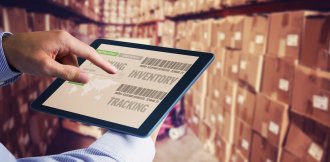
Contact us
Our team would love to hear from you.

In this article, we will dive deeper into the application of the Internet of Things to inventory management and pay attention to its core advantages.
Simply put, the IoT technology via smart sensors creates a network of physical objects which are able to interact and exchange information with each other and the external environment without any human intervention. This expands the functionality of objects allowing them to fulfill their traditional functions more efficiently. The information collected from the sensors is transmitted to the higher levels of the IoT system where it is processed and analyzed.
The use of the Internet of Things technology in inventory management enables significant competitive advantage in the company’s logistics activities. The implementation of the Internet of Things technology helps logistics companies quickly search for necessary goods, ensure that all the items are safely stored, see when goods are about to run out of stock, and more.
There are several useful ways to leverage the full potential of the Internet of Things in inventory management:
RFID technology. It is used to implement identification mechanisms in an intelligent warehouse system based on the IoT. It allows getting comprehensive information about each storage unit in real time. Here is how RFID works:
Smart sensors. They allow tracking inventory items on every stage and help address the majority of possible issues. Below are a few examples of how IoT sensors are used for inventory management:
NFC, BLE beacons, and good old barcodes are worth mentioning because they are still the most common technologies used for smart inventory tracking.

Inventory management using IoT
Thanks to the IoT, the need to track inventory manually is steadily decreasing. Each element is monitored automatically, and all the information about each item is stored in data storages (e.g. a simple database, local or cloud-based storage, or as a part of a data platform). Automated tracking and reporting can save hours of work time each month and reduce the chance of human error.
IoT smart sensors are gradually replacing more traditional asset monitoring systems (barcodes, tracking numbers). With the help of the Internet of Things, enterprises can track goods throughout the supply chain, collect detailed data about the inventory (storage temperature, transit time, etc.), improve quality control, and ensure timely delivery.
The IoT technology is also vital for the creation and further operation of an IoT-based Intelligent Warehouse Management System (WMS). A WMS is designed to ensure real-time data availability for such ERP subsystems as CRM and eCommerce. It allows establishing full and transparent integration with warehouse and logistics operations. Also, it makes data available for systems and services at any time.
The use of IoT sensors increases the security of warehouse storage systems. This aspect plays a particularly important role in the processes of sensitive goods logistics. The system of autonomous and continuous monitoring allows tracking conditions, determines the parameters of secure transportation and storage, and in case of violation of storage standards, the system can warn people around.
With the help of IoT-powered devices, inventory tracking and route planning identify the current location of the goods. This function is useful for delays tracking, emergency planning, and determining alternative ways to optimize the supply chain.
With smart sensors, inventory managers are more aware of the quantity and location of goods. Having all the data at hand in real time, it is much easier to control the amount of available stock and avoid chock-full warehouses.
IoT provides facilities for monitoring inventory from a manufacturer to a customer by creating a digital paper trail. Tracing items provides better inventory visibility, ensures that the product is transported in accordance with requirements (temperature, humidity, pressure, etc.), helps track the authenticity of goods, and greatly reduces inventory storage costs.
Despite the fact that the implementation of an IoT system and the RFID technology in inventory management may seem complicated and expensive, it is worth giving this technology a chance. In addition to improving the existing workflow, the technology acts as a springboard for future advancements.
Looking for high-quality IoT software development services? We are ready to share our expertise with you.
Our team would love to hear from you.
Fill out the form, and we’ve got you covered.
What happens next?
San Diego, California
4445 Eastgate Mall, Suite 200
92121, 1-800-288-9659
San Francisco, California
50 California St #1500
94111, 1-800-288-9659
Pittsburgh, Pennsylvania
One Oxford Centre, 500 Grant St Suite 2900
15219, 1-800-288-9659
Durham, North Carolina
RTP Meridian, 2530 Meridian Pkwy Suite 300
27713, 1-800-288-9659
San Jose, Costa Rica
C. 118B, Trejos Montealegre
10203, 1-800-288-9659